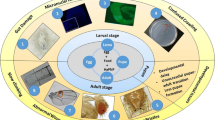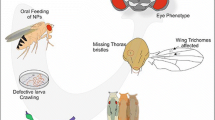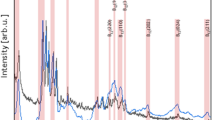Abstract
Hydroxyapatite Nanoparticle (HAp NPs) is similar to the crystal structure of human bone. It has excellent properties such as biocompatibility, osteoconductivity, and biodegradable. Owing to these properties, it has been used in the field of drug delivery, dental applications, and bone tissue engineering. PEG (Polyethylene glycol) is a synthetic biodegradable polymer. It prevents the agglomeration of the nanoparticles, surface oxidation of the particles and thereby making it more biocompatible. Rose Bengal (RB) is a photo sensitiser which has the ability to generate singlet oxygen. In the present study, PEG/HAp nanocomposite has been synthesised and characterised using DLS and Zeta potential, TEM, and FTIR. The safety efficacy of the PEG/HAp nanocomposite was studied in wild type Drosophila larvae and adult flies after oral administration. Larval crawling assay, negative geotaxis assay, survival assay, biochemical assays—SOD activity, DPPH activity and GSH activity were performed. This study showed that the nanocomposite did not affect the development of the larva rather it enhanced the behavioural and antioxidant activity. In the adult flies, the climbing activity and the survivability patterns were greatly improved. Earlier studies with HAp NPs on the Drosophila model did not enhance behavioural and antioxidant activities whilst in the present study, PEG might help in improving these activities due to its non-immunogenic and non-antigenic properties.










Similar content being viewed by others
References
Ahamed M, Posgai R, Gorey TJ, Nielsen M, Hussain SM, Rowe JJ (2010) Silver nanoparticles induced heat shock protein 70, oxidative stress and apoptosis in Drosophila melanogaster. Toxicol Appl Pharmacol 242(3):263–269. https://doi.org/10.1016/j.taap.2009.10.016
Alaraby M, Annangi B, Marcos R, Hernández A (2016) Drosophila melanogaster as a suitable in vivo model to determine potential side effects of nanomaterials: a review. J Toxicol Environ Health Part B 19(2):65–104. https://doi.org/10.1080/10937404.2016.1166466
Bag J, Mishra M (2020) Biochemical assays to detect the antioxidant level in Drosophila melanogaster. In: Mishra M (ed) Fundamental approaches to screen abnormalities in Drosophila. Springer Protocols Handbooks. Springer, New York. https://doi.org/10.1007/978-1-4939-9756-5_13
Bhowmick A, Pramanik N, Manna PJ, Mitra T, Raja Selvaraj TK, Gnanamani A, Das M, Kundu PP (2015) Development of porous and antimicrobial CTS–PEG–HAP–ZnO nano-composites for bone tissue engineering. RSC Adv 5(120):99385–99393. https://doi.org/10.1039/c5ra16755h
Canillas M, Pena P, De Aza AH, Rodríguez MA (2017) Calcium phosphates for biomedical applications. Bol Soc Esp Ceram Vidrio 56(3):91–112. https://doi.org/10.1016/j.bsecv.2017.05.001
Chen DH, Huang YW (2002) Spontaneous formation of Ag nanoparticles in dimethylacetamide solution of poly(ethylene glycol). J Colloid Interface Sci 255(2):299–302. https://doi.org/10.1006/JCIS.2002.8674
Dan P, Sundararajan V, Ganeshkumar H, Gnanabarathi B, Subramanian AK, Venkatasubu GD, Ichihara S, Ichihara G, Sheik Mohideen S (2019) Evaluation of hydroxyapatite nanoparticles-induced in vivo toxicity in Drosophila melanogaster. Appl Surf Sci 484:568–577. https://doi.org/10.1016/j.apsusc.2019.04.120
Devanand Venkatasubbu G, Ramasamy S, Ramakrishnan V, Kumar J (2011) Hydroxyapatite-alginate nanocomposite as drug delivery matrix for sustained release of ciprofloxacin. J Biomed Nanotechnol 7(6):759–767. https://doi.org/10.1166/jbn.2011.1350
Dhanalakshmi CP (2012) Synthesis and preliminary characterization of polyethylene glycol (PEG)/hydroxyapatite (HAp) nanocomposite for biomedical applications. Int J Phys Sci. https://doi.org/10.5897/IJPS11.1495
Eckman AM, Tsakalozou E, Kang NY, Ponta A, Bae Y (2012) Drug release patterns and cytotoxicity of PEG-poly(aspartate) block copolymer micelles in cancer cells. Pharm Res 29(7):1755–1767. https://doi.org/10.1007/S11095-012-0697-5
Ellman GL (1959) Tissue sulfydryl groups. Arch Biochem Biophys 82(1):70–77. https://doi.org/10.1016/0003-9861(59)90090-6
Feany MB, Bender WW (2000) A Drosophila model of Parkinson’s disease. Nature 404(6776):394–398. https://doi.org/10.1038/35006074
Ferguson CTJ, Al-Khalaf AA, Isaac RE, Cayre OJ (2018) pH-responsive polymer microcapsules for targeted delivery of biomaterials to the midgut of Drosophila suzukii. PLoS ONE 13(8):e0201294. https://doi.org/10.1371/journal.pone.0201294
Glanzman DL (2010) Common mechanisms of synaptic plasticity in vertebrates and invertebrates. Curr Biol 20(1):R31–R36. https://doi.org/10.1016/j.cub.2009.10.023
Hiraoka W, Honda H, Feril LB, Kudo N, Kondo T (2006) Comparison between sonodynamic effect and photodynamic effect with photosensitizers on free radical formation and cell killing. Ultrason Sonochem 13(6):535–542. https://doi.org/10.1016/j.ultsonch.2005.10.001
Hu Y, Zhao Z, Harmon T, Pentel PR, Ehrich M, Zhang C (2018) Paradox of PEGylation in fabricating hybrid nanoparticle-based nicotine vaccines. Biomaterials 182:72–81. https://doi.org/10.1016/j.biomaterials.2018.08.015
Huang FW, Wang HY, Li C, Wang HF, Sun YX, Feng J, Zhang XZ, Zhuo RX (2010) PEGylated PEI-based biodegradable polymers as non-viral gene vectors. Acta Biomater 6(11):4285–4295. https://doi.org/10.1016/J.ACTBIO.2010.06.016
Jovanović B, Cvetković VJ, Mitrović TL (2016) Effects of human food grade titanium dioxide nanoparticle dietary exposure on Drosophila melanogaster survival, fecundity, pupation and expression of antioxidant genes. Chemosphere 144:43–49. https://doi.org/10.1016/j.chemosphere.2015.08.054
Kalita SJ, Bhardwaj A, Bhatt HA (2007) Nanocrystalline calcium phosphate ceramics in biomedical engineering. Mater Sci Eng C 27 441–449. https://doi.org/10.1016/j.msec.2006.05.018
Kim P, Kim DH, Kim B, Choi SK, Lee SH, Khademhosseini A, Langer R, Suh KY (2005) Fabrication of nanostructures of polyethylene glycol for applications to protein adsorption and cell adhesion. Nanotechnology 16(10):2420. https://doi.org/10.1088/0957-4484/16/10/072
Klaassen CD (1976) Pharmacokinetics of rose Bengal in the rat, rabbit, dog, and guinea pig. Toxicol Appl Pharmacol 38(1):85–100. https://doi.org/10.1016/0041-008X(76)90163-0
Koevary SB (2012) Selective toxicity of rose bengal to ovarian cancer cells in vitro. Int J Physiol Pathophysiol Pharmacol 4(2):99
Laskar P, Dey J, Ghoshkumar S (2016) Evaluation of zwitterionic polymersomes spontaneously formed by pH-sensitive and biocompatible PEG based random copolymers as drug delivery systems. Colloids Surf B 139:107–116. https://doi.org/10.1016/J.COLSURFB.2015.11.042
León A, Reuquen P, Garín C, Segura R, Vargas P, Zapata P, Orihuela PA (2017) FTIR and Raman characterization of TiO2 nanoparticles coated with polyethylene glycol as carrier for 2-methoxyestradiol. Appl Sci. https://doi.org/10.3390/app7010049
Li S, Liu Q, De Wijn J, De Groot K, Zhou B (1996) Biomimetic coating of bioactives ceramic on bamboo for biomedical applications. J Mater Sci Lett 15(21):1882–1885. https://doi.org/10.1007/BF00264085
Linderman JA, Chambers MC, Gupta AS, Schneider DS (2012) Infection-related declines in chill coma recovery and negative geotaxis in Drosophila melanogaster. PLoS ONE 7(9):e41907. https://doi.org/10.1371/JOURNAL.PONE.0041907
Lu B-Q, Zhu Y-J, Chen F (2014) Highly flexible and nonflammable inorganic hydroxyapatite paper. Chemistry 20(5):1242–1246. https://doi.org/10.1002/CHEM.201304439
Manna A, Pramanik S, Tripathy A, Moradi A, Radzi Z, Pingguan-Murphy B, Hasnan N, Abu Osman NA (2016) Development of biocompatible hydroxyapatite-poly(ethylene glycol) core-shell nanoparticles as an improved drug carrier: structural and electrical characterizations. RSC Adv 6(105):102853–102868. https://doi.org/10.1039/c6ra21210g
Milla P, Cattel FD (2012) Pegylation of proteins and liposomes: a powerful and flexible strategy to improve the drug delivery. Curr Drug Metab 13(1):105–119. https://doi.org/10.2174/13892001279835693
Mohideen SS, Yamasaki Y, Omata Y, Tsuda L, Yoshiike Y (2015) Nontoxic singlet oxygen generator as a therapeutic candidate for treating tauopathies. Sci Rep 5:1–14. https://doi.org/10.1038/srep10821
Mostafa NY, Brown PW (2007) Computer simulation of stoichiometric hydroxyapatite: structure and substitutions. J Phys Chem Solids 68(3):431–437
Mousavi S, Hersey P (2007) Role of caspases and reactive oxygen species in Rose Bengal-induced toxicity in melanoma cells. Iran J Basic Med Sci 2(34):118–123
Mousavi S, Dong Zhang X, Sharifi A, Hersey P (2006) Study of rose bengal-induced cell death in melanoma cells in the absence of light. Iran J Basic Med Sci 3(31):216–222
Nel A, Xia T, Mädler L, Li N (2006) Toxic potential of materials at the nanolevel. Science 311(5761):622–627. https://doi.org/10.1126/SCIENCE.1114397
Niedermayer S, Weiss V, Herrmann A, Schmidt A, Datz S, Müller K, Wagner E, Bein T, Bräuchle C (2015) Multifunctional polymer-capped mesoporous silica nanoparticles for pH-responsive targeted drug delivery. Nanoscale 7:7953. https://doi.org/10.1039/c4nr07245f
Niidome T, Yamagata M, Okamoto Y, Akiyama Y, Takahashi H, Kawano T, Katayama Y, Niidome Y (2006) PEG-modified gold nanorods with a stealth character for in vivo applications. J Control Release 114(3):343–347. https://doi.org/10.1016/j.jconrel.2006.06.017
Niska K, Knap N, Kędzia A, Jaskiewicz M, Kamysz W, Inkielewicz-Stepniak I (2016) Capping agent-dependent toxicity and antimicrobial activity of silver nanoparticles: an in vitro study. Concerns about potential application in dental practice. Int J Med Sci 13(10):772–782. https://doi.org/10.7150/ijms.16011
Nosrati H, Sarraf-Mamoory R, Le DQS, Perez MC, Bünger CE (2020a) Evaluation of argon-gas-injected solvothermal synthesis of hydroxyapatite crystals followed by high-frequency induction heat sintering. Cryst Growth Des 20(5):3182–3189. https://doi.org/10.1021/acs.cgd.0c00048
Nosrati H, Sarraf-Mamoory R, Le DQS, Zolfaghari Emameh R, Canillas Perez M, Bünger CE (2020b) Improving the mechanical behavior of reduced graphene oxide/hydroxyapatite nanocomposites using gas injection into powders synthesis autoclave. Sci Rep 10(1):1–13. https://doi.org/10.1038/s41598-020-64928-y
Nosrati H, Sarraf Mamoory R, Le Svend DQ, Bünger CE (2020c) Fabrication of gelatin/hydroxyapatite/3D-graphene scaffolds by a hydrogel 3D-printing method. Mater Chem Phys 239:122305. https://doi.org/10.1016/j.matchemphys.2019.122305
Nosrati H, Le DQS, Zolfaghari Emameh R, Canillas Perez M, Bünger CE (2021) Nucleation and growth of brushite crystals on the graphene sheets applicable in bone cement. Bol Soc Esp Ceram Vidrio. https://doi.org/10.1016/j.bsecv.2020.05.001
Okada T (1993) Complexation of poly(oxyethylene) in analytical chemistry a review. Analyst 118(8):959–971. https://doi.org/10.1039/AN9931800959
Oliveira JM, Rodrigues MT, Silva SS, Malafaya PB, Gomes ME, Viegas CA, Dias IR, Azevedo JT, Mano JF, Reis RL (2006) Novel hydroxyapatite/chitosan bilayered scaffold for osteochondral tissue-engineering applications: Scaffold design and its performance when seeded with goat bone marrow stromal cells. Biomaterials 27(36):6123–6137. https://doi.org/10.1016/j.biomaterials.2006.07.034
Pandey UB, Nichols CD (2011) Human disease models in drosophila melanogaster and the role of the fly in therapeutic drug discovery. Pharmacol Rev 63(2):411–436. https://doi.org/10.1124/pr.110.003293
Pappus SA, Ekka B, Sahu S, Sabat D, Dash P, Mishra M (2017) A toxicity assessment of hydroxyapatite nanoparticles on development and behaviour of Drosophila melanogaster. J Nanoparticle Res. https://doi.org/10.1007/s11051-017-3824-8
Photos PJ, Bacakova L, Discher Ba, Bates FS, Discher DE (2003) Polymer vesicles in vivo: correlations with PEG molecular weight. J Control Release 90:323–334
Posgai R, Ahamed M, Hussain SM, Rowe JJ, Nielsen MG (2009) Inhalation method for delivery of nanoparticles to the Drosophila respiratory system for toxicity testing. Sci Tot Environ 408(2):439–443. https://doi.org/10.1016/j.scitotenv.2009.10.008
Pramanik N, Bhargava P, Alam S, Pramanik P (2006) Processing and properties of nano- and macro-hydroxyapatite/poly(ethylene-co-acrylic acid) composites. Polym Compos 27(6):633–641. https://doi.org/10.1002/PC.20246
Pramanik S, Ataollahi F, Pingguan-Murphy B, Oshkour AA, Osman NAA (2015) In vitro study of surface modified poly(ethylene glycol)-impregnated sintered bovine bone scaffolds on human fibroblast cells. Sci Rep 5:1–11. https://doi.org/10.1038/srep09806
Ragaseema VM, Unnikrishnan S, Kalliyana Krishnan V, Krishnan LK (2012) The antithrombotic and antimicrobial properties of PEG-protected silver nanoparticle coated surfaces. Biomaterials 33(11):3083–3092. https://doi.org/10.1016/j.biomaterials.2012.01.005
Sapre N, Chakraborty R, Purohit P, Bhat S, Das G, Bajpe SR (2020) Enteric pH responsive cargo release from PDA and PEG coated mesoporous silica nanoparticles: a comparative study in Drosophila melanogaster. RSC Adv 10(20):11716–11726. https://doi.org/10.1039/c9ra11019d
Sarkar A, Mahendran TS, Meenakshisundaram A, Christopher RV, Dan P, Sundararajan V, Jana N, Venkatasubbu D, Sheik Mohideen S (2021) Role of cerium oxide nanoparticles in improving oxidative stress and developmental delays in Drosophila melanogaster as an in-vivo model for bisphenol a toxicity. Chemosphere 284:131363. https://doi.org/10.1016/j.chemosphere.2021.131363
Shrestha A, Hamblin MR, Kishen A (2012) Characterization of a conjugate between Rose Bengal and chitosan for targeted antibiofilm and tissue stabilization effects as a potential treatment of infected dentin. Antimicrob Agents Chemother 56(9):4876–4884. https://doi.org/10.1128/AAC.00810-12
Siepmann J, Podual K, Sriwongjanya M, Peppas NA, Bodmeirer (1999) A new model describing the swelling and drug release kinetics from hydroxypropyl methylcellulose tablets. J Pharm Sci 88(1):65–72. https://doi.org/10.1021/JS9802291
Siepmann F, Muschert S, Flament MP, Leterme P, Gayot J, Siepmann (2006) Controlled drug release from gelucire-based matrix pellets: experiment and theory. Int J Pharm 317(2):136–143. https://doi.org/10.1016/J.IJPHARM.2006.03.006
Su TT (2019) Drug screening in Drosophila; why, when, and when not? Wires Dev Biol 8(6):e346. https://doi.org/10.1002/wdev.346
Sundararajan V, Dan P, Kumar A, Venkatasubbu GD, Ichihara S, Ichihara G, Sheik Mohideen S (2019) Drosophila melanogaster as an in vivo model to study the potential toxicity of cerium oxide nanoparticles. Appl Surf Sci 490:70–80. https://doi.org/10.1016/j.apsusc.2019.06.017
Sundararajan V, Venkatsubbu GD, Sheik MS (2021) Investigation of therapeutic potential of cerium oxide nanoparticles in Alzheimer’s disease using transgenic Drosophila. 3 Biotech 11:159. https://doi.org/10.1007/s13205-021-02706-x
Teixeira S, Rodriguez MA, Pena P, De Aza AH, De Aza S, Ferraz MP, Monteiro FJ (2009) Physical characterization of hydroxyapatite porous scaffolds for tissue engineering. Mater Sci Eng C 29:1510–1514. https://doi.org/10.1016/j.msec.2008.09.052
Tzafriri AR (2000) Mathematical modeling of diffusion-mediated release from bulk degrading matrices. J Controll 63(1–2):69–79. https://doi.org/10.1016/S0168-3659(99)00174-1
Venkatasubbu GD, Ramasamy S, Avadhani GS, Ramakrishnan V, Kumar J (2013) Surface modification and paclitaxel drug delivery of folic acid modified polyethylene glycol functionalized hydroxyapatite nanoparticles. Powder Technol 235:437–442. https://doi.org/10.1016/j.powtec.2012.11.003
Zeng X, Liu G, Tao W, Ma Y, Zhang X, He F, Pan J, Mei L, Pan G (2017) A drug-self-gated mesoporous antitumor nanoplatform based on ph-sensitive dynamic covalent bond. Adv Func Mater 27(11):1605985. https://doi.org/10.1002/ADFM.201605985
Zhu YJ (2017) Nanostructured materials of calcium phosphates and calcium silicates: synthesis, properties and applications. Chin J Chem 35(6):769–790. https://doi.org/10.1002/cjoc.201600696
Acknowledgements
The authors thank the department of biotechnology, SRM IST for the support. The authors acknowledge the HRTEM FACILITY at SRMIST setup with support from MNRE (Project No.31/03/2014-15/PVSE-R&D), Government of India.
Author information
Authors and Affiliations
Corresponding author
Ethics declarations
Conflict of interest
The authors declare no conflict of interest.
Additional information
Publisher's Note
Springer Nature remains neutral with regard to jurisdictional claims in published maps and institutional affiliations.
Rights and permissions
About this article
Cite this article
Dan, P., Senthilkumar, S., Gopinath, D.V. et al. Safety studies of polyethylene glycol–hydroxyapatite nanocomposites on Drosophila melanogaster: an in vivo model. Appl Nanosci 12, 225–236 (2022). https://doi.org/10.1007/s13204-021-02284-7
Received:
Accepted:
Published:
Issue Date:
DOI: https://doi.org/10.1007/s13204-021-02284-7




